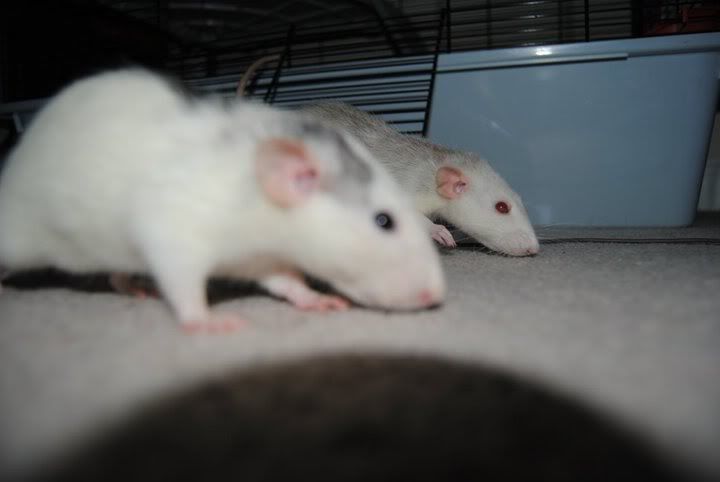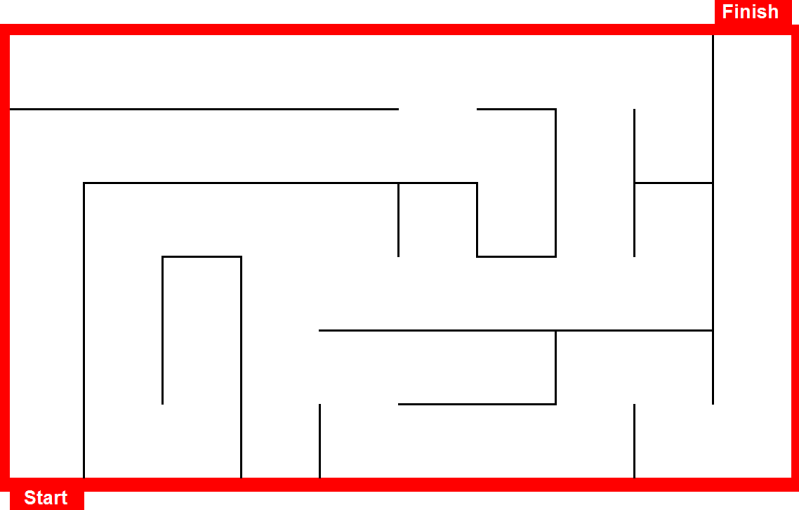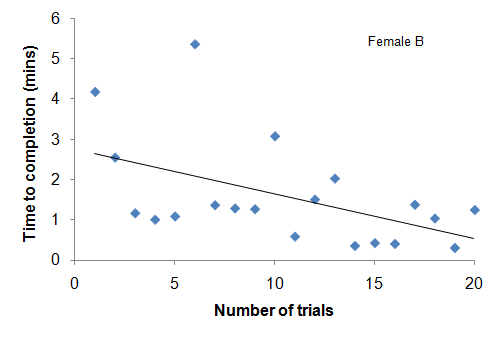Learning in domestic rats
Introduction
Though animal behaviour was studied long before the word ‘ethology’ was applied (Aristotle in particular made numerous interesting observations), ethology in its modern form is generally seen to have arisen in the 1930s, with the work of Nikolaas Tinbergen. Tinbergen was a Dutch biologist – it is partially due to his efforts that the study of animal behaviour became an independent scientific discipline in it's own right.
 |
| Nikolaas Tinbergen (1907 - 1988) |
The brown rat Rattus norvegicus is historically and currently an important organism in biological research, and is frequently used as the subject in medical and psychological experiments. This is due to a number of reasons, such as their intelligence, the readiness with which they accomodate to the special conditions of the laboratory, the relative ease with which they may be kept and bred in captivity, and how swiftly they grow to sexual maturity. Biologists have looked at innumerable aspects of their behaviour, including motivational conflict, number judgement and spatial discrimination.
A significant component of animal behaviour is learning. At the start of the 20th century, the behaviour of animals was studied in this context, notably by Thorndike in 1911 and Pavlov in 1927. Rats have been used in maze-based experiments/studies since this time. Hundreds of studies have looked at how rats run different types of mazes. This type of research has helped outline general principles about learning that may be applied to other species, including us. As well as this, it contributes to behavioural neuroscience, by looking at the effect of different treatments and conditions (for example, in what ways does a rat’s performance change when exposed to different types of music? After manipulation of different parts of the brain? After being given certain drugs?)
With Tinbergen’s questions in mind, this investigation aimed to study behaviour in rats, with a focus on spatial learning and memory, by testing ability to memorize a complex route. Four fancy rats (domestic brown rats) – two females and two males – were run through a type of rodent maze called a classic maze, during early March 2011.
The Classic Maze
The maze consisted of a medium-density fibre-board base (3ft by 2ft, 6mm thick) and a series of vertical walls made from cardboard and held together with hot glue. A galvanized mesh panel (25mm mesh) formed the ceiling. At the start and finish locations entrance and exit ‘doors’ were cut into the walls. A food reward was present at the finish.
With Tinbergen’s questions in mind, this investigation aimed to study behaviour in rats, with a focus on spatial learning and memory, by testing ability to memorize a complex route. Four fancy rats (domestic brown rats) – two females and two males – were run through a type of rodent maze called a classic maze, during early March 2011.
 |
| Females A and B |
The Classic Maze
The maze consisted of a medium-density fibre-board base (3ft by 2ft, 6mm thick) and a series of vertical walls made from cardboard and held together with hot glue. A galvanized mesh panel (25mm mesh) formed the ceiling. At the start and finish locations entrance and exit ‘doors’ were cut into the walls. A food reward was present at the finish.
Each hungry rat was run through the maze 20 times, starting in one location and finishing in another. For each trial, time taken to complete the maze (using a stopwatch) and number of errors were recorded. An error was defined as taking a wrong turn or back-tracking in the wrong direction.
 |
| Bird's eye / top down view of the classic maze design (diagrammatic representation) |
In general, over repeated trials, time to completion and number of errors made decreased. The rats tended to clear the maze more and more quickly, with fewer and fewer errors.
To show this, below is part of the data recorded for Female B. Time taken to clear the maze (in minutes) is plotted against number of trials; there is a decreasing trend. A similar trend-line was created when plotting number of errors against number of trials. The results for the other three rats followed this pattern.
Discussion
Tinbergen's questions represent four ways of asking "Why does the animal behave in this way?" He argued that ethology always needs to include four kinds of explanation in any instance of behaviour, and that these explanations are complimentary/over-lapping rather than exclusive. A complete analysis requires both proximate and ultimate perspectives.
The rat uses external and spatial cues, such as the location of the observer (which was the same each time) and patterns within the maze structure (e.g. irregularities in the cardboard walls) to help it learn the route through which the maze may be navigated (memory and cognitive maps).
1. Causation (proximate mechanisms/cause-effect relations)
What causes the rat to complete the maze? What are the mechanisms underlying the learning behaviour? Machinery operating within the animal is responsible for the production of the observed behavioural output. In this case, the behaviour is induced by hunger, a strong physiological mechanism in most if not all organisms; the presence of a desirable, strong-smelling food reward provides motivation (the stimuli that elicits the response) to journey through and complete the maze. The central hunger mechanism and its control have been studied extensively in the laboratory rat. The machinery of this central mechanism comprises several nuclei in the hypothamalus, including the paraventricular, ventromedial and lateral. Bolhuis and Giraldeau note that activation of these nuclei can result in decreased or increased food intake.
2. Development (ontogeny)
How did the behaviour develop or come about in the lifetime of an animal? Internal and external factors influence the way this behaviour develops in the lifetime of an individual. Bolhius and Giraldeau state that learning is often interpreted as being part of behavioural development; this is because learning, like other developmental processes, involves changes in the mechanisms underlying behaviour over time. Genes have a role in programming learning behaviour in rats, while hunger develops early in an organism's lifespan.
3. Function (adaptation)
What is the behaviour's function? Why is it a benefit to fitness? The ability to learn is of energetic value to a rat - the less energy expended making mistakes and retracing their steps through the maze (or a series of tunnels in the wild), the better. Learning/memory also functions in helping to keep the animal alive and propagate its genes into the next generation, in that a rat able to learn/adapt/problem-solve in this way is more likely to be successful. There is considerable evidence for a durable and capacious long-term memory in rats - this is a benefit to fitness/survival/the individual in that rats able to remember where food is are at an advantage. The function behind a rat's response to the reward (seeking it out and consuming it) is to intake energy for the purposes of survival - the function of eating is to aquire nutrients, although the immediate cause of eating is hunger (causation: see above).
4. Evolution (phylogeny)
How did this behaviour come about in the course of evolution? How did the behaviour evolve? A rat's 'talent' for running mazes makes sense when their evolutionary history is taken into consideration. As small rodents that sometimes burrow, in their evolutionary history rats have spent time navigating underground tunnels - it may be said that such pressures in the evolutionary history of the rat have a hand in the evolution of it's ability to learn and that environments from their evolutionary past have helped shaped this behaviour. In addition, hunger is evolutionarily ancient. Part of this question also asks how behaviour in an organism relates to the same behaviour in similar related species - mice have also been used in maze-based learning studies.
The rat uses external and spatial cues, such as the location of the observer (which was the same each time) and patterns within the maze structure (e.g. irregularities in the cardboard walls) to help it learn the route through which the maze may be navigated (memory and cognitive maps).
1. Causation (proximate mechanisms/cause-effect relations)
What causes the rat to complete the maze? What are the mechanisms underlying the learning behaviour? Machinery operating within the animal is responsible for the production of the observed behavioural output. In this case, the behaviour is induced by hunger, a strong physiological mechanism in most if not all organisms; the presence of a desirable, strong-smelling food reward provides motivation (the stimuli that elicits the response) to journey through and complete the maze. The central hunger mechanism and its control have been studied extensively in the laboratory rat. The machinery of this central mechanism comprises several nuclei in the hypothamalus, including the paraventricular, ventromedial and lateral. Bolhuis and Giraldeau note that activation of these nuclei can result in decreased or increased food intake.
2. Development (ontogeny)
How did the behaviour develop or come about in the lifetime of an animal? Internal and external factors influence the way this behaviour develops in the lifetime of an individual. Bolhius and Giraldeau state that learning is often interpreted as being part of behavioural development; this is because learning, like other developmental processes, involves changes in the mechanisms underlying behaviour over time. Genes have a role in programming learning behaviour in rats, while hunger develops early in an organism's lifespan.
3. Function (adaptation)
What is the behaviour's function? Why is it a benefit to fitness? The ability to learn is of energetic value to a rat - the less energy expended making mistakes and retracing their steps through the maze (or a series of tunnels in the wild), the better. Learning/memory also functions in helping to keep the animal alive and propagate its genes into the next generation, in that a rat able to learn/adapt/problem-solve in this way is more likely to be successful. There is considerable evidence for a durable and capacious long-term memory in rats - this is a benefit to fitness/survival/the individual in that rats able to remember where food is are at an advantage. The function behind a rat's response to the reward (seeking it out and consuming it) is to intake energy for the purposes of survival - the function of eating is to aquire nutrients, although the immediate cause of eating is hunger (causation: see above).
4. Evolution (phylogeny)
How did this behaviour come about in the course of evolution? How did the behaviour evolve? A rat's 'talent' for running mazes makes sense when their evolutionary history is taken into consideration. As small rodents that sometimes burrow, in their evolutionary history rats have spent time navigating underground tunnels - it may be said that such pressures in the evolutionary history of the rat have a hand in the evolution of it's ability to learn and that environments from their evolutionary past have helped shaped this behaviour. In addition, hunger is evolutionarily ancient. Part of this question also asks how behaviour in an organism relates to the same behaviour in similar related species - mice have also been used in maze-based learning studies.
Try it yourself
This experiment is easily replicable; the materials are available in the home and in DIY stores. Rats needn’t be the focus – other small rodent companion animals, such as hamsters and mice, can also be used.
Find out more
- Tinbergen N. 1963. On aims and methods of ethology. Zeitschrift für Tierpsychologie 20, 410-433 (http://apophenia.wdfiles.com/local--files/start/tinbergen.pdf)
- Bolhuis JJ and Giraldeau L. 2006. The Behavior of Animals: Mechanisms, Function and Evolution. Blackwell Publishing
 |
| Male B running the maze |



Hey All !!
ReplyDeleteCongratulation to all of you. It is very nice blog site. This is my first time i visit here. I found so many entertaining stuff in your blog, especially its discussion, I guess I am not the only one having all the enjoyment here! Keep up the good work.
Bilirubin Assay Kit
Thanks a lot again.
Thanks a lot for this contribution! It's been very useful for me. I would like to thank for the efforts you have put in writing this blog. I am hoping the same high-grade blog post from you in the upcoming days as well.Cholesterol Assay Kit
ReplyDelete